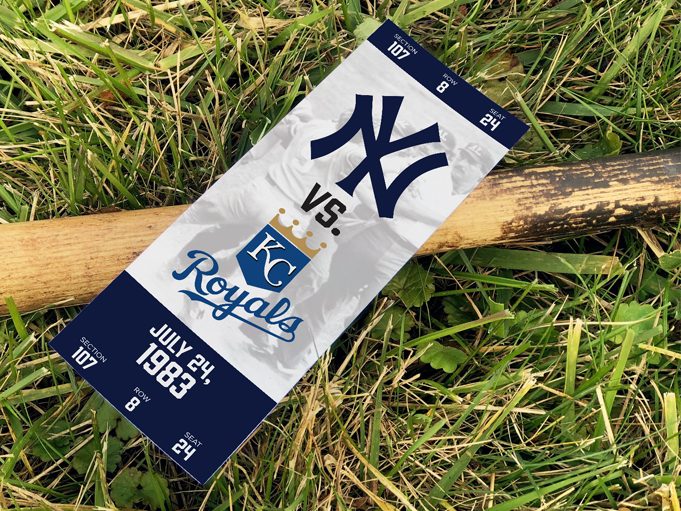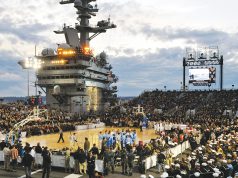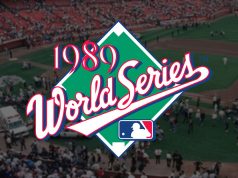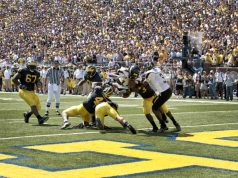As Tim McClelland walked toward his gate at New York’s LaGuardia International Airport the evening of July 24, 1983, the first-year AL umpire had to pass through a gauntlet of Kansas City Royals players glaring at him. “It was the proverbial, if looks could kill, I’d be dead,” McClelland recalled.
Earlier that day at Yankee Stadium, the then 31-year-old McClelland became the focal point of one of the national pastime’s great controversies simply by enforcing a rule. It was an obscure, easily misunderstood and somewhat silly rule, yet when McClelland applied it that 82-degree afternoon in New York, he was to soon find himself on the front page of every sports section in the country.
35 years later, that memorable showdown between the Yankees and Royals is remembered as “The Pine Tar Incident.” And what a mess it was, both in terms of George Brett’s bat and longterm ramifications.
That Sunday afternoon before a crowd of 33,944, Brett had hit a two-run homer with two outs in the top of the ninth inning to give the Royals an apparent 5-4 lead. That is until Yankees Manager Billy Martin protested that Brett should be ruled out because he had applied pine tar to his bat that exceeded the 18-inch limit spelled out in rule 1.10 (b).
McClelland, who worked home plate that day, measured the bat and conferred with crew chief Joe Brinkman, and crew members Drew Coble and the late Nick Bremigan before ruling that Brett was out. That meant the game was over, since Brett became the third out of the inning, and the Yankees won, 4-3.
Considering both teams entered that afternoon two games out of first place in their respective divisions, McClelland’s ruling could have had an enormous impact on the playoff picture that October. Brett, realizing the potential ramifications, sprinted out of the dugout toward the umpires, saucer-eyed and with his arms flailing, in what was one of the most memorable tirades ever caught on film.
The seeds of that great controversy were actually sown two weeks earlier when Yankees third baseman Graig Nettles noticed excessive pine tar on Brett’s bat during a game at Kansas City. The word was passed on to Martin, who decided to save that tip for the most opportune occasion. It didn’t remain tucked away in Martin’s memory bank for long. With the Yankees leading, 4-3, with two outs in the top of the ninth inning, the Royals’ U.L. Washington singled off Dale Murray. Relief ace Rich Gossage was brought in to face Brett, who sent Gossage’s second pitch into the rightfield bleachers. “Brett was running the bases and Martin yelled from out of the dugout, ‘Get the bat! Grab the bat!’” said McClelland. “(Yankees catcher Rick) Cerone had thrown it to the bat boy for Kansas City, so he went and grabbed it from the bat boy and handed it to me. By that time, Martin was out at the plate area and was saying, ‘He’s got too much pine tar on his bat! You’ve got to call him out!’” The umpires ultimately decided to measure Brett’s bat on the 17-inch wide home plate and, when they did, they had no choice — Brett was out. “Once I called him out, George came charging out of the dugout,” McClelland said. “Joe Brinkman grabbed him, and a couple of players were around us at the time. “As that was going on, (Royals pitcher) Gaylord Perry, being the man of foreign substance that he was, grabbed the bat out of my hands and tossed it to Rocky Colavito (a Royals coach). I took a couple steps toward Colavito and he raised the bat like he was going to hit me with it. So I stopped and he tossed it to somebody else.
“I’m not sure who the last guy was to get it, but it was about two or three passes and then they ran it up the tunnel to the clubhouse. Joe Brinkman and I chased them up and there was a security guard at the top of the tunnel. He stopped the last guy, and Joe got the bat.”
Case closed? Hardly. As this melodrama played out, it was then-AL President Lee MacPhail — and not McClelland — who had the final say. Four days later, MacPhail issued the peculiar statement that while the umpires were technically correct, Brett’s bat did not violate “the spirit of the rules.” MacPhail went on to point out that the intent of the rule was to discipline batters using a doctored bat, “to increase distance potential, but not to treat pinetar excesses in the same manner.”
“That was where I had a little problem,” said McClelland. “We don’t umpire on the spirit of the rules. We umpire on the letter of the law, and the rules said that we needed to call him out. If I would have turned to Billy Martin and said, ‘Billy, you know you’re right by the rules, but come on, he just hit a home run in the ninth inning and it’s not in the spirit of the rules,’ Billy Martin would have protested and we would have lost the protest. I’ll probably be the first one to admit that it wasn’t a good rule, but we can’t rule on the good ones and not rule on the bad ones.”
MacPhail’s decision restored Brett’s home run, meaning the game had to be completed. That happened on August 18 at Yankee Stadium, where the last four outs of the game were uneventfully played out and it went in the books as a 5-4 Royals victory. McClelland, Brinkman, Coble and Bremigan were not even on hand, working their regularly scheduled game at Anaheim that night.
The possibility of a second such incident was eliminated that winter when Major League Baseball changed the rule to read: “If the umpire discovers that the bat does not conform to (the pine tar rule) until a time during or after which the bat has been used in play, it shall not be grounds for declaring the batter out or ejected from the game.”
“There’s no penalty anymore, so you can do whatever you want to do,” Brinkman said. “You can use a bat with pine tar all the way to the end if you want.”
What's Your Call? Leave a Comment:
Note: This article is archival in nature. Rules, interpretations, mechanics, philosophies and other information may or may not be correct for the current year.
This article is the copyright of ©Referee Enterprises, Inc., and may not be republished in whole or in part online, in print or in any capacity without expressed written permission from Referee. The article is made available for educational use by individuals.

















